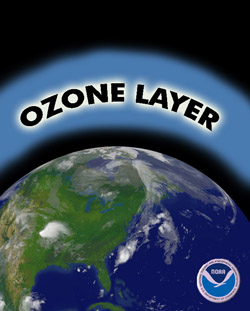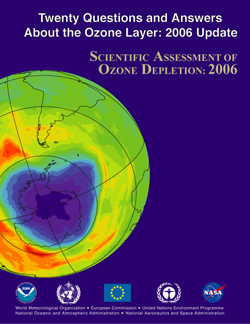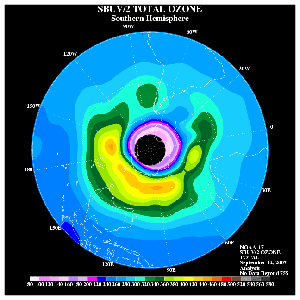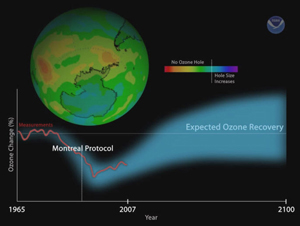| NOAA Magazine || NOAA Home Page |
NOAA OBSERVES 20TH ANNIVERSARY OF THE MONTREAL PROTOCOL
 September
16, 2007 — More than two decades
ago, NOAA scientist Susan
Solomon and her colleagues discovered the chemistry behind the cause
of the Antarctic ozone hole. Today, NOAA
continues to lead scientific efforts in this area.
September
16, 2007 — More than two decades
ago, NOAA scientist Susan
Solomon and her colleagues discovered the chemistry behind the cause
of the Antarctic ozone hole. Today, NOAA
continues to lead scientific efforts in this area.
The signing of the Montreal Protocol on Substances that Deplete the Ozone Layer, marks a landmark international agreement to phase out the production and consumption of ozone-depleting chemicals. The signing of this agreement 20 years ago was and still is critically important, since without the stratospheric ozone layer the Earth would not be shielded from the sun’s damaging UV-B radiation, which can adversely affect human health and ecosystems. Since the inception of the Montreal Protocol, NOAA has played a leading role in providing policy makers with the scientific information needed to track and assess the effectiveness of the Protocol and make appropriate adjustments to it.
|
|
The
Most Successful Multilateral Environmental Agreements to Date
The Montreal Protocol, along with its subsequent amendments,
is considered by many to be the most successful multilateral environmental
agreement to date. Since being enacted in 1987, it has resulted in a
significant reduction in global emissions of ozone depleting substances
and there are signs that ozone
depletion is slowly recovering.
“Both CFC and ozone levels are showing signs of leveling off and some CFCs have even started to decrease,” said David Hofmann, director of NOAA’s Earth System Research Laboratory, Global Monitoring Division in Boulder, Colo. “As a result, the world's fragile ozone layer is predicted to gradually return to its original state by the second half of this century.”
NOAA’s
Ozone Accomplishments
NOAA's
engages in many activities that focus on the recovery of the ozone layer.
These activities, conducted by NOAA’s Office
of Oceanic and Atmospheric Research, as well as NOAA’s National
Weather Service and NOAA’s Satellites
and Information Service, have helped ensure that efforts to heal
the ozone layer stay on course. Through its meticulous monitoring of
the atmospheric composition and scientific expertise in understanding
processes and modeling, as well as the search for ozone-friendly alternatives,
NOAA has and continues to provide much of the global scientific foundation
for understanding the ozone layer and its changes. Recent accomplishments
include:
- NOAA
Research Led the 2006
International Ozone Assessment:
NOAA’s ESRL, not only headed up the most recent International
Ozone Assessment in 2006, but it provided much of the data/research
that allowed the Assessment to claim, for the first time, that ozone
depleting substances in the atmosphere have actually decreased. Many
NOAA scientists throughout OAR, NWS, and NESDIS also served as lead
authors, coauthors, contributors, reviewers, and coordinating editor
for this Assessment. NOAA research on the observations, understanding,
and modeling of the ozone layer were also cited extensively in the
2006 report.
 Twenty
Questions and Answers About the Often-Complex Science Of Ozone Depletion:
David
W. Fahey, a scientist with NOAA’s ESRL Chemical Sciences Division,
served as lead author of the chapter on "Twenty Questions and
Answers About the Ozone Layer: 2006 Update" that was a part of
the 2006 international scientific assessment described above. The
chapter was also published as a separate booklet so the scientific
community, as well as educators, students, the general public, and
decision makers could have easy access to this valuable resource.
Twenty
Questions and Answers About the Often-Complex Science Of Ozone Depletion:
David
W. Fahey, a scientist with NOAA’s ESRL Chemical Sciences Division,
served as lead author of the chapter on "Twenty Questions and
Answers About the Ozone Layer: 2006 Update" that was a part of
the 2006 international scientific assessment described above. The
chapter was also published as a separate booklet so the scientific
community, as well as educators, students, the general public, and
decision makers could have easy access to this valuable resource.
“The questions address the nature of atmospheric ozone, the chemicals that cause ozone depletion, how global and polar ozone depletion occur, and what could lie ahead for the ozone layer,” said Fahey. “Both brief answers and a more expanded explanation to each question are provided. The answers are based on the information presented in the 2006 and earlier Assessment reports.”
- New
Ozone Depleting Gas Index:
Answers to questions about ozone depletion and the recovery of the
ozone hole are now much easier to obtain thanks to the ozone depletion
index developed by NOAA’s ESRL. The index is a number between
zero and 100 that tracks the decline in ozone-depleting gases from
a value of 100 at the maximum in ozone-depleting gases observed in
the 1990s to a value of zero at the level at which ozone recovery
is expected. The annually updated index illustrates when the ozone
hole and the ozone layer at mid-latitudes will fully recover if nations
continue to reduce their use of these gases.
"I like to think of it as a 100-yard football field," said Hofmann. "For full recovery, we have to run those 100 yards. The 2006 data indicate that we're still on our own 14-yard line, with 86 yards still to go, for Antarctic ozone hole recovery. For midlatitude ozone recovery, we've reached our own 25-yard line, with 75 yards to go. We've got a long way to go in both cases." Hofmann estimated that the Antarctic ozone hole should be gone by the years 2075-2080. The midlatitude ozone layer should recover by about 2045-2050. However, other factors, such as climate change, could affect long-term recovery, he cautioned.
The index allows policy-makers, as well as the general public, to better assess the effectiveness of the Montreal Protocol in reducing ozone depleting gases in the atmosphere.
- Tropical
Composition, Cloud and Climate Coupling (TC4) experiment:
NOAA scientists were among those who contributed to efforts in Costa
Rica to collect information on a variety of chemicals affecting the
stratospheric ozone layer. Scientists taking part in the TC4 experiment,
which ran from July 2 to August 15, 2007, measured ozone-depleting
chemicals including CFCs and CFC substitutes (such as HCFC-22 and
methyl iodide — an important alternative to the ozone-depleting
fumigant methyl bromide). Until recently, we thought oceans were the
only important source of methyl iodide. Now we know the Amazon and
other land areas can be sources,” said NOAA/ESRL scientist James
Elkins. “Now we have to look into what this, and man-made methyl
iodide, mean for the ozone layer.” This is just one example
of how NOAA also monitors the abundance and impacts of more ozone-friendly
substitutes as they become more popular in the marketplace.
 The
Montreal Protocol has also Reduced Greenhouse Gases: Scientists
at NOAA’s ESRL and their colleagues also recently discovered
that the Montreal Protocol is not only helping to protect the ozone
layer, but it has an additional benefit — it has helped
to slow global warming by an amount equivalent to seven to 12
years of rise in carbon dioxide in the atmosphere. The double effect
occurred because the gases that deplete the ozone layer are also greenhouse
gases. The relative climate forcing effect of the long-lived ozone-depleting
gases, compared to that of carbon dioxide, can be seen in the NOAA
Annual Greenhouse Gas Index (AGGI), compiled from ESRL data each
year.
The
Montreal Protocol has also Reduced Greenhouse Gases: Scientists
at NOAA’s ESRL and their colleagues also recently discovered
that the Montreal Protocol is not only helping to protect the ozone
layer, but it has an additional benefit — it has helped
to slow global warming by an amount equivalent to seven to 12
years of rise in carbon dioxide in the atmosphere. The double effect
occurred because the gases that deplete the ozone layer are also greenhouse
gases. The relative climate forcing effect of the long-lived ozone-depleting
gases, compared to that of carbon dioxide, can be seen in the NOAA
Annual Greenhouse Gas Index (AGGI), compiled from ESRL data each
year.
"The nations participating in the Montreal Protocol have done something very good for our climate," says Fahey. "While addressing ozone depletion, they also provided an early start on slowing climate change."
The amount of greenhouse gases curbed by the Montreal Protocol is equivalent to five times the reduction target for the first phase of the Kyoto Protocol, a 2005 international agreement to address climate change. The Kyoto Protocol did not regulate ozone-depleting chemicals because the prior agreements of the Montreal Protocol had already dealt with them.
The science conducted by NOAA scientists and their colleagues provides the scientific basis for the success of the Montreal Protocol. This is an example of how NOAA's science informs those who make decisions that affect our daily lives. NOAA research indicating that the Montreal Protocol is also helping to slow climate change further illustrates the multiplier effect of NOAA's targeted research and its benefits on multiple sectors of science.
Relevant
Web Sites
NOAA
NOAA Earth System Research Laboratory
NOAA Satellite Image of Ozone Hole
NOAA Aeronomy Lab: Stratospheric Ozone Layer (Antarctic, Arctic, and Global)
Reports to the Nation on Our Changing Planet: Our Ozone Shield
SCIENTISTS BRAVE BRUTAL ELEMENTS ON TOP OF THE WORLD TO STUDY OZONE LAYER
NOAA SCIENTIST RECEIVES PRESTIGIOUS AWARD FOR WORK ON OZONE HOLE
NOAA SCIENTIST RECEIVES NATION'S HIGHEST SCIENTIFIC HONOR
NOAA, NSF OBSERVE 20TH ANNIVERSARY OF OZONE HOLE 'SUCCESS STORY'
Media
Contact:
Anatta, NOAA
Research, 303-497-6288 or Jana
Goldman, NOAA Research, (301)
713-2483
